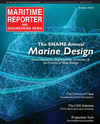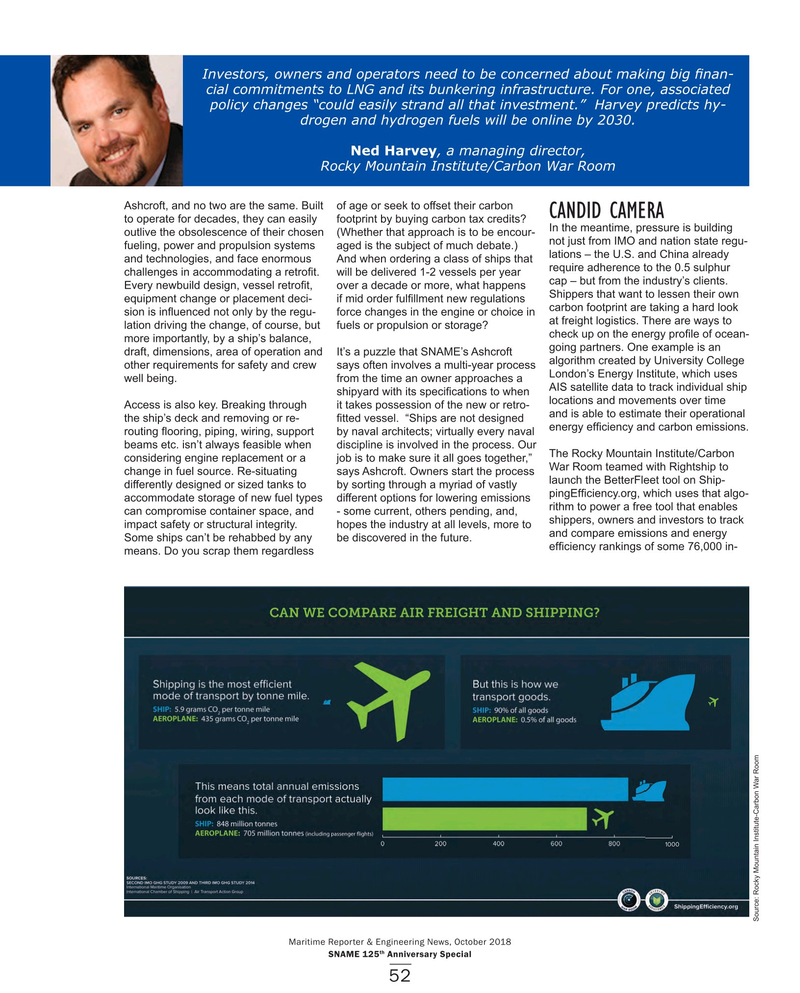
Page 52: of Maritime Reporter Magazine (October 2018)
Marine Design Annual
Read this page in Pdf, Flash or Html5 edition of October 2018 Maritime Reporter Magazine
Investors, owners and operators need to be concerned about making big ? nan- cial commitments to LNG and its bunkering infrastructure. For one, associated policy changes “could easily strand all that investment.” Harvey predicts hy- drogen and hydrogen fuels will be online by 2030.
Ned Harvey, a managing director,
Rocky Mountain Institute/Carbon War Room
Ashcroft, and no two are the same. Built of age or seek to offset their carbon
CANDID CAMERA to operate for decades, they can easily footprint by buying carbon tax credits?
In the meantime, pressure is building outlive the obsolescence of their chosen (Whether that approach is to be encour- not just from IMO and nation state regu- fueling, power and propulsion systems aged is the subject of much debate.) lations – the U.S. and China already and technologies, and face enormous And when ordering a class of ships that require adherence to the 0.5 sulphur challenges in accommodating a retro? t. will be delivered 1-2 vessels per year cap – but from the industry’s clients.
Every newbuild design, vessel retro? t, over a decade or more, what happens
Shippers that want to lessen their own equipment change or placement deci- if mid order ful? llment new regulations carbon footprint are taking a hard look sion is in? uenced not only by the regu- force changes in the engine or choice in at freight logistics. There are ways to lation driving the change, of course, but fuels or propulsion or storage? check up on the energy pro? le of ocean- more importantly, by a ship’s balance, going partners. One example is an draft, dimensions, area of operation and It’s a puzzle that SNAME’s Ashcroft other requirements for safety and crew says often involves a multi-year process algorithm created by University College
London’s Energy Institute, which uses well being. from the time an owner approaches a
AIS satellite data to track individual ship shipyard with its speci? cations to when locations and movements over time
Access is also key. Breaking through it takes possession of the new or retro- and is able to estimate their operational the ship’s deck and removing or re- ? tted vessel. “Ships are not designed energy ef? ciency and carbon emissions. routing ? ooring, piping, wiring, support by naval architects; virtually every naval beams etc. isn’t always feasible when discipline is involved in the process. Our
The Rocky Mountain Institute/Carbon considering engine replacement or a job is to make sure it all goes together,”
War Room teamed with Rightship to change in fuel source. Re-situating says Ashcroft. Owners start the process launch the BetterFleet tool on Ship- differently designed or sized tanks to by sorting through a myriad of vastly pingEf? ciency.org, which uses that algo- accommodate storage of new fuel types different options for lowering emissions rithm to power a free tool that enables can compromise container space, and - some current, others pending, and, shippers, owners and investors to track impact safety or structural integrity. hopes the industry at all levels, more to and compare emissions and energy
Some ships can’t be rehabbed by any be discovered in the future. ef? ciency rankings of some 76,000 in- means. Do you scrap them regardless
Source: Rocky Mountain Institute-Carbon War Room
Maritime Reporter & Engineering News, October 2018 th
SNAME 125 Anniversary Special 52
MR #10 (50-57).indd 52 MR #10 (50-57).indd 52 10/5/2018 10:33:20 AM10/5/2018 10:33:20 AM

 51
51

 53
53
